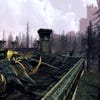What can topple World of Warcraft?
Rivals and analysts answer.
"World of Warcraft was one of those rare games that hit a nerve at the right time and became a kind of cultural phenomenon," Age of Conan's director Craig Morrison reasons. "It was a crossover hit that went beyond the genre's usual audience. I would even go as far as to suggest that it is unhealthy for the industry to hold the statistical performance of World of Warcraft as a standard by which other titles should be fairly judged."
That sort of success Morrison says you don't plan for, you can't plan for - "that kind of thing just happens". "Likewise," he adds, "you don't topple a cultural phenomenon. But you can join one."
But can anything ever topple World of Warcraft? "Yes, and it's an unequivocal yes," Morrison states. "But I have the feeling that the next game to share that success will be nothing like World of Warcraft, and none of us know what it is yet, otherwise everyone would already be working on it!
"[Blizzard] made a good, solid, well-executed game with a strong sense of place. They focused on creating an almost flawless core gameplay experience, and expanded after launch. We need to keep those goals."
Today's flock of once would-be World of Warcraft rivals are slowly turning free-to-play because, as Jack Emmert once put it, Blizzard "sucked the oxygen" from the subscription market. Turbine's the leader of this pack, having had copy-worthy success from turning Dungeons & Dragons free to play. The Lord of the Rings Online - a game whose April 2007 arrival rocked the WOW boat - has just followed suit here in Europe.
Consider LOTRO for a moment. Here is a game that got 9/10 on Eurogamer (and another 9/10 after its F2P relaunch), a result of combining the world's most revered fantasy licence with a studio responsible for Asheron's Call. There were even television campaigns at launch. But still World of Warcraft reigned supreme.
"If I knew what could topple WOW I'd be making it!" blurts David Solari, general manager of Codemasters Online - the company that runs LOTRO in Europe. "But broadly I'd imagine it would have mass market appeal, with instant accessibility, would work on all platforms, particularly mobile, be incredibly viral and social - like a feature-rich FarmVille. I have a few thoughts, but of course I can't give them away."
"I do think that there is a significant part of the overall MMO audience now that migrates between games," he adds. "They might go back to WOW for six months or try something new - or go back to another MMO they played previously that has been given new content. What I do know is nothing lasts forever. World of Warcraft's dominance will likely continue but eventually something will supersede it."
That's of course assuming that Blizzard doesn't have the same bright free-to-play idea. GamersFirst bought the corpse of APB for a pittance and is attempting to jolt Realtime Worlds' tragic game back to life with a free-to-play model.
"Does anything have to topple World of Warcraft?" asks Bjorn Book-Larsson, head of GamersFirst. "At some point, [Blizzard] might consider doing free-to-play stuff. They tried selling the mount or in-game riding thing for $25 and it was a big success. They're making so much money they don't really have to change model, but they would actually make more money using free-to-play. World of Warcraft has a lot of upside growth ahead of it if it went free-to-play.
"But I don't think anything needs to topple it," he said. "The market is big enough and the number of gamers in the world is growing at such a clip that as any game developer or publisher we should be able to find a good-quality audience."
The most recent blockbuster MMO to butt heads with Blizzard's titan was NCsoft's Aion, which amassed nearly half-a-million pre-orders ahead of its Western arrival last September. But Aion's real success was and is in Asia, where the game counts around three million subscribers (exact numbers aren't known and could be lower).





